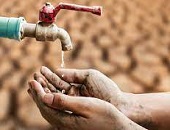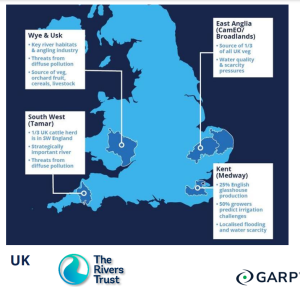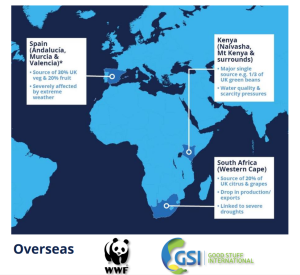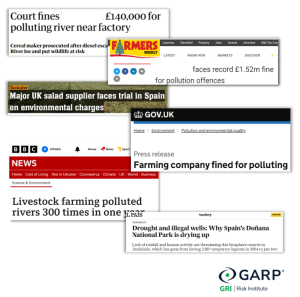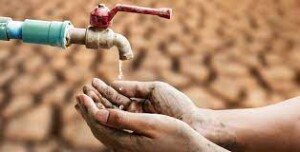Flooding, drought, and the polluted quality of water pose a business risk to the agricultural sector, which affects everything from geopolitical risk to inflation. What is the cause of water risk, and how can it be mitigated?
On October 3, 2023, Catherine David, Director of Collaboration and Change at Waste and Resources Action Programme (WRAP) and a specialist in water risk, spoke about water management designed for sustainability. The webinar was sponsored by the Global Association of Risk Professionals (GARP) and was moderated by Jo Paisley, President, GARP Risk Institute.
“According to the FAO,” David said, “by 2030, global demand for water is expected to double while the United Nations predicts a 40 percent water shortfall.” FAO refers to the Food and Agriculture Organization, a specialized agency of the UN, that leads international efforts to defeat hunger and improve nutrition and food security.
“The UN describes climate change as ‘primarily a water crisis,’” she said, because water will become scarce, unpredictable, and polluted. There is “horrible inequity” in water risk.
She noted that in England, “fewer than 20 percent of our rivers are in good overall health. Agricultural practices affects nearly two-thirds of our river water bodies.” She referred to news items about chicken farming polluting rivers inland.
“Much of the productive land in the Mediterranean is at risk due to pressure on water supply” and extreme events as global heating continues.
Collective Action Projects
David outlined four collective action projects being run by WRAP in England: in East Anglia, Kent, Wye catchment, and the Southwest (Tamar) region, as shown on the map below.
WRAP is also engaged in three collective action projects overseas: in Spain, Kenya, and South Africa.
Governments are making water and nature a higher policy priority. “Investors and governments require evidence of risk management,” she said. “Besides, it makes simply good commercial sense.”
If you get water risk wrong, there is a significant reputational risk because people are confronted with evidence of water risk. “Streams are going dry, basements are flooded,” she said. “Customers increasingly blame food businesses for harm to water resources.”
All in all, “water stewardship is integral to good environmental, social and corporate governance” or ESG ratings. A new law has come into effect, for larger businesses in April 2022, and it will be mandatory across the entire U.K. economy by 2025. There will be mandatory climate-related financial disclosure. Such reporting must include:
• Arrangements for identifying, assessing and managing water risks, and
• Targets, and performance against those targets.
She described the increasing risks from inaction, and gave examples of legal obligations and harm to reputation by leading food & beverage corporations. “Chicken poo in the local water supply is not the story you want to be associated with,” she said.
To help them report on climate-related financial disclosures, businesses are turning to the curiously named “Water Roadmap,” put out by WRAP.
U.K. Policy Drivers
David pointed to three policies developed by government agencies that relate to water risk.
First, there is the U.K. Environment Act and Environmental Improvement Plan (EIP23) that aims to restore 75 percent of English water bodies to good ecological status. Second, there is the climate-change conference COP26 commitment by the U.K. and other governments to ensure that the water footprints they control and influence will be “fair” by 2030.
Third, there are River Basin Management Plans, “mainly related to agricultural phosphorus,” she noted.
She urged businesses to make a start on tackling water risk. She presented the Target-Measure-Act paradigm as the best route to follow. “Sign up to the Water Roadmap. Review and assess supply chain risk. We collect a huge amount of qualitative data.”
What is The Water Roadmap?
WRAP has a water risk target it calls “Cortauld 2030.” They want to source at least 50 percent of the U.K.’s fresh food and drink from areas with sustainable water management by 2030.
She showed a slide with an impressive number of corporate logos on it, including major brands such as Tesco and Marks & Spencer, that have signed on. “The food sector is a little bit ahead of the other sectors” such as the textiles sector.
She said the World Water Forum (WWF) Water Stewardship Ladder “had become common language between businesses.” She noted, “The Ladder sets out the steps a business should take to reduce water risk. It involves going beyond site-based water management to address water issues at a catchment level using collective action.”
Supply Chain
Why focus on the supply chain? She agreed that a water risk assessment of directly operated sites is an important first step. “However, the biggest water risk and water footprint for a food & drink business is in the supply chain.”
“That’s why we advise mapping supply chains using WWF’s Water Risk Filter, identifying water risk hotspots and joining collective action projects in high-risk sourcing areas.”♠️
Click here to access the WRAP report “Food and Drink 2030.”
Click here to read our blog posting about COP26 (November 2021).
Click here to view the one-hour webinar featuring Jo Paisley and Catherine David.

